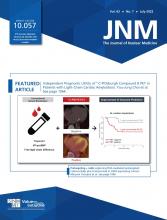TO THE EDITOR: We read with great interest the recent article by Gafita et al. published in The Journal of Nuclear Medicine (1). They observed that patients with a very high tumor load showed a significantly lower SUV in healthy organs on a 68Ga-prostate-specific membrane antigen (PSMA) PET scan, suggesting a tumor sink effect. A comparable observation was also described by Gaertner et al. (2). These authors postulated that a similar effect might occur with PSMA-targeted radioligand therapy. However, dissimilar results regarding the tumor sink effect have also been reported (3).
Although the results of Gafita et al. may support higher treatment activities of 177Lu-PSMA for those with a very high volume of disease (≥1,355 mL), there were actually no significant differences in the SUVmean of healthy organs between a very low volume of disease (<25 mL) and a high volume (<1,355 mL). These results are in line with what we recently observed in a therapeutic 177Lu-PSMA study on patients with low-volume metastatic hormone-sensitive prostate cancer (4,5). We saw that the dosimetry results based on posttherapeutic SPECT imaging in patients with a maximum of 10 prostate cancer metastases—or a very low volume of metastasis following the definition of Gafita et al.—were comparable to previously reported results on patients with high-volume metastatic prostate cancer (6–8). This result suggests that the sink effect in the setting of low-volume metastatic disease may be of less concern than is commonly anticipated.
There are also important limitations to Gafita’s study that need to be considered and also apply to the previous work investigating the sink effect. The authors did not take into account tracer pharmacokinetics or perform dosimetry but based their results on a single-time-point SUV as a surrogate for radiation dose. This choice limits the accuracy with which the radiation dose for 177Lu-PSMA can be estimated, particularly as uptake in healthy organs and tumor occurs over a prolonged time (5,9). The observed effect could thus relate to an early differential distribution of tracer to tumors in a very high-volume setting (≥1,355 mL), which does not exist at later time points. Moreover, the precursor used for PSMA imaging (e.g., PSMA-11) and PSMA therapy (e.g., PSMA-617) generally differ and may thus confound the outcomes. The study was also prone to bias due to its retrospective multicenter design with varying local scan protocols. Therefore, the differences between a very low and a very high volume of disease may have differed using a different study strategy.
All in all, we do believe there is a relevant sink effect but want to emphasize that the present data suggest that patients with a very low volume of metastatic disease or oligometastases can safely benefit from PSMA radioligand therapy and should not be excluded after this recent report. A prospective study with a low oligometastatic volume and a high volume of disease in a homogeneous cohort of patients that includes dosimetry is awaited. Moreover, a post hoc analyses of the VISION data that compares the adverse events (e.g., xerostomia) in patients with low-volume and high-volume metastasis may lead to a better understanding. As a final note, the definition of high volume and low volume used in the studies also differs from what urooncologists think of as high and low volumes, as they generally follow the CHAARTED or LATTITUDE criteria (10). We therefore urge future studies to base their reports on criteria that are more commonly used.
Footnotes
Published online Jan. 13, 2022.
- © 2022 by the Society of Nuclear Medicine and Molecular Imaging.







